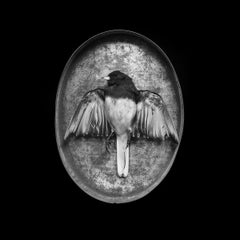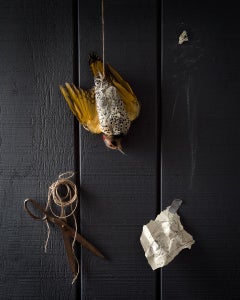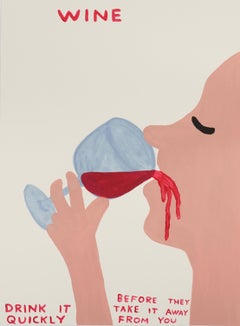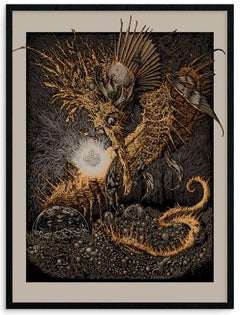Gothic Still-life Prints
to
1
1
1
Overall Width
to
Overall Height
to
1,253
720
360
227
207
104
81
78
72
47
43
30
19
14
1
1
2
1
2
1
2
2
1
1
1
1
1
1
2
1
1
1
1
3
2
1
Style: Gothic
Four Groups of Nine Grotesque Masks
By Alò Giovannoli
Located in London, GB
4 Groups of 9 plates of Grotesque Masks.
[Published: Venanzio Monaldini, Rome, 1781].
Rare and strong impressions of etchings of grotesque masks, after...
Category
1780s Gothic Still-life Prints
Materials
Handmade Paper, Etching, Engraving
Dark Eyed Junco (Junco Hyemalis)
Located in Red Bank, NJ
Dark Eyed Junco (Junco Hyemalis) by Kimberly Witham
Photography, Prints, Bird, Animal, Gothic, Dark Colors
Category
20th Century Gothic Still-life Prints
Materials
Dye Transfer
After Harnett
Located in Red Bank, NJ
After Harnett by Kimberly Witham
Print, Animal, Still-Life, Bird, Gothic, Dark Colors, Textured
Category
20th Century Gothic Still-life Prints
Materials
Rag Paper, Archival Pigment
Related Items
Wine
Located in Manchester, GB
David Shrigley, Wine, 2021
Hand-signed and dated on the reverse
Edition 29 of 125
75 x 56 cm
Screenprint in colours
Private Collection UK
Category
2010s Gothic Still-life Prints
Materials
Screen
The Celestial Hippocampus (Ed. 88/140)
Located in Dallas, TX
"The Scar by China Miéville is a novel which has been a part of my life for many years, and has travelled as my companion through since adolescence. I've attempted to depict the Avan...
Category
21st Century and Contemporary Gothic Still-life Prints
Materials
Screen
Magnolia 10 - Contemporary Figurative Drypoint Etching Print, Flower, Floral
Located in Warsaw, PL
MARTA WAKUŁA-MAC: Master of Arts in Fine Art Education- Diploma in Fine Art Printmaking at the Institute of Art, Pedagogical University, Krakow, 2003. Member of Graphic Studio Dubl...
Category
2010s Gothic Still-life Prints
Materials
Paper, Drypoint, Etching
Cocoa plant, caterpillar, ..., Plate 26, Metamorphosis Insectorum Surinamensium
Located in Middletown, NY
Metamorphosis Insectorum Surinamensium, Plate No. 26; Cocoa plant, caterpillar, pupa, and butterflies. The Netherlands: 1705. En...
Category
Early 18th Century Gothic Still-life Prints
Materials
Watercolor, Engraving
The Roost, Box Set of 5 limited edition prints (ed. 30)
Located in New York, NY
This box set of prints includes 5 limited edition prints signed by the artist. (Edition of 30)
This newly released, print set by Thomas Broadbent ...
Category
2010s Gothic Still-life Prints
Materials
Archival Paper, Archival Pigment
$1,850
H 13 in W 16 in D 0.5 in
Breakfast - Pop Art, Post War, Color Etching, 1995
Located in Palm Desert, CA
“Breakfast” is a colored etching and drypoint by American artist, Wayne Thiebaud from 1995. The work is edition 22/50 and is signed lower right, "Thiebaud 1995”
Wayne Thiebaud's Bre...
Category
Late 20th Century Gothic Still-life Prints
Materials
Paper, Drypoint, Etching
"La Mer VE 1/8" Intaglio, hand colored, seashell motif
Located in Philadelphia, PA
This piece titled "La Mer VE 1/8" is a variable edition piece by Kate VanVliet and is made from two-plate intaglio with drypoint, aquatint, and soft ground on Rives BFK. This piece i...
Category
21st Century and Contemporary Gothic Still-life Prints
Materials
Archival Paper, Color, Etching, Intaglio, Drypoint, Aquatint
Thistle and Moths, plate no. 6, Metamorphosis Insectorum Surinamensium
Located in Middletown, NY
Metamorphosis Insectorum Surinamensium, Plate No. 6; Thistle and Moths. The Netherlands: 1705. Engraving with hand coloring in w...
Category
Early 18th Century Gothic Still-life Prints
Materials
Watercolor, Engraving
$5,300
H 12.88 in W 9.63 in
Silver Rock Melon: A Framed 19th C. Color Engraving by George Brookshaw
Located in Alamo, CA
This is a 19th century colored aquatint and stipple engraving finished by hand entitled "Silver Rock Melon", drawn and engraved by George Brookshaw and published in London in 1812 as plate 67 in his 'Pomona Britannica; or, A Collection of the Most Esteemed Fruits'. It depicts a Silver Rock Melon still on the vine, but the melon lies on a heater green mat. A wedge of the melon has been dissected to reveal its inner anatomy, including the seeds. The melon skin is a heather and light green color, while the inner portions are a light peach color. The vine and leaves are shown attractive shades of light green and there are soft yellow flowers. The plant is displayed on a light brown textured background with shadows to impart 3-dimensionality. The scene is reminiscent of an engraving in an 18th century artistically stylized human anatomy atlas. There are wide white margins. The title and inscription lies within the lower border.
This striking engraving is presented in a reddish brown decorative wood frame with a darker brown scroll-work outer trim and a gold-colored inner fillet and a thick heather green mat. The frame measures 25.75" high, 21.5" wide and 1.13" deep. It is glazed with UV conservation glass. There is a short thin vertical line of discoloration in the lower margin through the word "melon" and a tiny spot in the upper margin on the left. The print and frame are otherwise in excellent condition.
There is a second Brookshaw engraving that is framed in identical moulding, although a slightly different size and a different color mat. t depicts a cluster of grapes. The two prints would make a striking display pairing...
Category
Early 19th Century Gothic Still-life Prints
Materials
Engraving, Aquatint
$8,975
H 25.75 in W 21.5 in D 1.13 in
Tree with moth, caterpillar..., Plate 39, Metamorphosis Insectorum Surinamensium
Located in Middletown, NY
Metamorphosis Insectorum Surinamensium, Plate No. 39; Unidentified tree with moth, caterpillar and pupa.
The Netherlands: 1705....
Category
Early 18th Century Gothic Still-life Prints
Materials
Watercolor, Engraving
A Sledge of Kamtschatka – An image of a relic from Captain Cook's third voyage
By John Webber
Located in Middletown, NY
London: Scatcherd & Whitaker, 1784.
Etching with hand coloring in watercolor on cream wove paper, 7 1/2 x 10 (190 x 255); sheet 16 1/4 x 22 (414 x 560 mm), full margins. In good cond...
Category
Late 18th Century Gothic Still-life Prints
Materials
Watercolor, Handmade Paper, Etching
$350
H 7.49 in W 10.04 in
Lily Scent
Located in New York, NY
Robert Rauschenberg
Lily Scent, 1981
Lithograph
32 x 24 inches
SPIII
Signed
Category
1980s Gothic Still-life Prints
Materials
Lithograph
Gothic still-life prints for sale on 1stDibs.
Find a wide variety of authentic Gothic still-life prints available for sale on 1stDibs. Works in this style were very popular during the 20th Century, but contemporary artists have continued to produce works inspired by this movement. Many Pop art paintings were created by popular artists on 1stDibs, including and Alò Giovannoli. Frequently made by artists working with Paper, and Archival Pigment Print and other materials, all of these pieces for sale are unique and have attracted attention over the years. Not every interior allows for large Gothic still-life prints, so small editions measuring 15 inches across are also available. Prices for still-life prints made by famous or emerging artists can differ depending on medium, time period and other attributes. On 1stDibs, the price for these items starts at $1,800 and tops out at $41,702, while the average work sells for $1,850.




